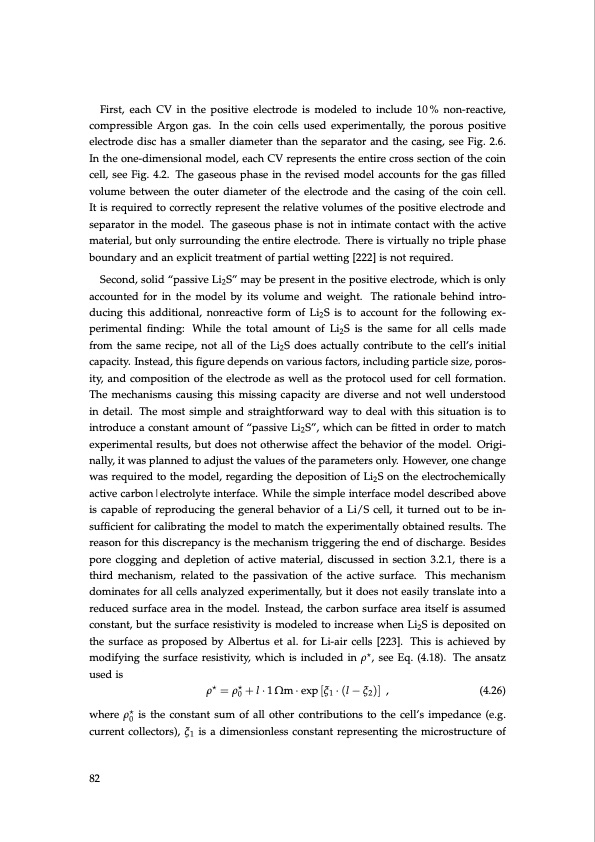
PDF Publication Title:
Text from PDF Page: 082
First, each CV in the positive electrode is modeled to include 10% non-reactive, compressible Argon gas. In the coin cells used experimentally, the porous positive electrode disc has a smaller diameter than the separator and the casing, see Fig. 2.6. In the one-dimensional model, each CV represents the entire cross section of the coin cell, see Fig. 4.2. The gaseous phase in the revised model accounts for the gas filled volume between the outer diameter of the electrode and the casing of the coin cell. It is required to correctly represent the relative volumes of the positive electrode and separator in the model. The gaseous phase is not in intimate contact with the active material, but only surrounding the entire electrode. There is virtually no triple phase boundary and an explicit treatment of partial wetting [222] is not required. Second, solid “passive Li2S” may be present in the positive electrode, which is only accounted for in the model by its volume and weight. The rationale behind intro- ducing this additional, nonreactive form of Li2S is to account for the following ex- perimental finding: While the total amount of Li2S is the same for all cells made from the same recipe, not all of the Li2S does actually contribute to the cell’s initial capacity. Instead, this figure depends on various factors, including particle size, poros- ity, and composition of the electrode as well as the protocol used for cell formation. The mechanisms causing this missing capacity are diverse and not well understood in detail. The most simple and straightforward way to deal with this situation is to introduce a constant amount of “passive Li2S”, which can be fitted in order to match experimental results, but does not otherwise affect the behavior of the model. Origi- nally, it was planned to adjust the values of the parameters only. However, one change was required to the model, regarding the deposition of Li2S on the electrochemically active carbon|electrolyte interface. While the simple interface model described above is capable of reproducing the general behavior of a Li/S cell, it turned out to be in- sufficient for calibrating the model to match the experimentally obtained results. The reason for this discrepancy is the mechanism triggering the end of discharge. Besides pore clogging and depletion of active material, discussed in section 3.2.1, there is a third mechanism, related to the passivation of the active surface. This mechanism dominates for all cells analyzed experimentally, but it does not easily translate into a reduced surface area in the model. Instead, the carbon surface area itself is assumed constant, but the surface resistivity is modeled to increase when Li2S is deposited on the surface as proposed by Albertus et al. for Li-air cells [223]. This is achieved by modifying the surface resistivity, which is included in ρ⋆, see Eq. (4.18). The ansatz used is ρ⋆ =ρ0⋆+l·1Ωm·exp[ξ1·(l−ξ2)] , (4.26) where ρ0⋆ is the constant sum of all other contributions to the cell’s impedance (e.g. current collectors), ξ1 is a dimensionless constant representing the microstructure of 82PDF Image | Lithium-Sulfur Battery: Design, Characterization, and Physically-based Modeling

PDF Search Title:
Lithium-Sulfur Battery: Design, Characterization, and Physically-based ModelingOriginal File Name Searched:
Dissertation_David_N._Fronczek_The_Lithium_Sulfur_Battery.pdfDIY PDF Search: Google It | Yahoo | Bing
Sulfur Deposition on Carbon Nanofibers using Supercritical CO2 Sulfur Deposition on Carbon Nanofibers using Supercritical CO2. Gamma sulfur also known as mother of pearl sulfur and nacreous sulfur... More Info
CO2 Organic Rankine Cycle Experimenter Platform The supercritical CO2 phase change system is both a heat pump and organic rankine cycle which can be used for those purposes and as a supercritical extractor for advanced subcritical and supercritical extraction technology. Uses include producing nanoparticles, precious metal CO2 extraction, lithium battery recycling, and other applications... More Info
| CONTACT TEL: 608-238-6001 Email: greg@infinityturbine.com | RSS | AMP |